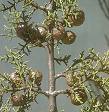Sargent Cypress Tree Information
Images of Sargent Cypress:






Sargent Cypress grows in the following 2 states and provinces:
California, HawaiiInformation about Sargent Cypress:
as well ashe Cupressus Sargentii is commonly known as the Sargent Cypress.
The currently accepted scientific name of Sargent cypress is Cupressus sargentii Jeps. (Cupressaceae) . There are two recognized varieties : Cupressus sargentii var. sargentii Cupressus sargentii var. duttonii Jeps. Natural hybridization between Sargent cypress and MacNab cypress (Cupressus macnabiana) has been hypothesized, but evidence for it is inconclusive . Sargent cypress occurs only in California and has the widest distribution of all of the coastal California cypress . Numerous scattered groves occur in the Coast Ranges from northern Mendocino County south to Santa Barbara County . Sargent cypress is cultivated in Hawaii . Sargent cypress is a component of the northern interior cypress forest. This community is an open, fire-maintained, scrubby forest similar to the knobcone pine (Pinus attenuata) forest. Sargent cypress occurs in widely scattered, isolated groves throughout its range. It occurs in dense thickets as well as in open groves and sparse stands . Dense thickets are common in burned areas . Sargent cypress is associated with serpentine chaparral, and intergrades on less severe sites with upper Sonoran mixed chaparral, montane chaparral, or knobcone pine forest community types. On more mesic sites the northern interior cypress forest intergrades with mixed evergreen forest or montane coniferous forest . Sargent cypress is associated with redwood (Sequoia sempervirens)-Douglas-fir (Pseudotsuga menziesii) forest and associated North Coast forests in Mendocino County, California . It is commonly associated with chaparral and gray pine (Pinus sabiniana) throughout its range . In some areas, Sargent cypress is associated with yellow pine (Pinus ponderosa and P. jeffreyi) forests, closed-cone coniferous woodlands, and pine-cedar-cypress pygmy forests . Sargent cypress occurs sympatrically with MacNab cypress in Lake County, California, where it is larger and tends to occupy lower slopes than MacNab cypress . Publications naming Sargent cypress as a community dominant are listed below. California chaparral The closed-cone pines and cypress Preliminary descriptions of the terrestrial natural communities of California Species not previously mentioned but commonly associated with Sargent cypress include sugar pine (Pinus lambertiana), Coulter pine (P. coulteri), bigcone Douglas-fir (Pseudotsuga macrocarpa), incense-cedar (Libocedrus decurrens), bigleaf maple (Acer macrophyllum), California scrub oak (Quercus dumosa), leather oak (Q. durata), huckleberry oak (Q. vaccinifolia), musk brush (Ceanothus jepsonii), wedgeleaf ceanothus (C. cuneatus), coyote ceanothus (C. ferrisae), dwarf ceanothus (C. pumilis), bigberry manzanita (Arctostaphylos glauca), whiteleaf manzanita (A. viscida), serpentine manzanita (A. obispoensis), Tamalpais manzanita (A. pungens var. montana), hoary manzanita (A. canescens), Mariposa manzanita (A. mariposa), chamise (Adenostoma fasciculatum), interior silktassel (Garrya congdonii), boxleaf silktassel (G. buxifolia), California bay (Umbellaria californica), chaparral yucca (Yucca whipplei), tree poppy (Dendromecon rigida), yerba santa (Eriodictyon californicum), California juniper (Juniperus californica), and twistflower (Streptanthus spp.) .Some of the information provided here is attributed to:Esser, Lora L. 1994. Cupressus sargentii. In: Fire Effects Information System, [Online]. U.S. Department of Agriculture, Forest Service, Rocky Mountain Research Station, Fire Sciences Laboratory (Producer). , available at the USDA Fire Effects Information System (FEIS) website